Waelcyrge is the Gaelic spelling of the word Valkyrie. And the Valkyries, are apparently winged figures of Anglo-Saxon mythology. They come swiftly over the battlefield after the dust has settled, and choose at random, the lucky souls that are destined to Valhalla (Heaven). And loosely linked to this, the Vikings may have brought to Britain when they invaded, the practice of planting Yew trees in their graveyards, as a means of linking the bodies below with Valhalla above. Yew trees still grow in English graveyards to this day. The first Viking king of Britain was King Canute, who was famously placed on the beach by his supporters, in the belief that the sea would hold itself back in his presence. It didn’t. He got his feet wet.
And why am I telling you this somewhat shaky history?
Well because Waelcyrge is the name of my boat.
She was made by a master craftsman, who lived in England at the time, and who made her from a Yew tree in an English graveyard, that had to come down. He cut it down, planked it, and made it into this:
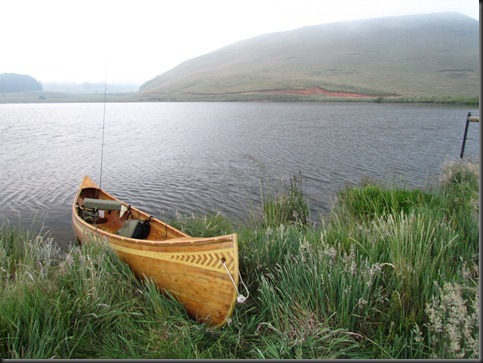
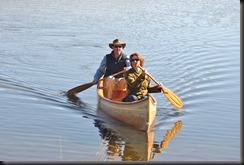
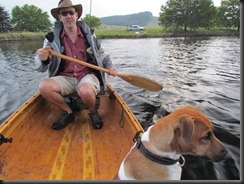
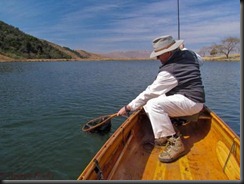
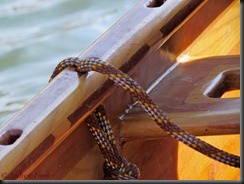
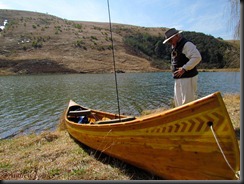
Beautiful isn’t she!
Heavenly you might say. I came upon her by chance (although I was driving at the time, not flying) I was driving down the street just around the corner from work (not the battlefield), when I saw her in a shop window. I actually drove past several times, but the tug became too strong and one day I pulled over and knocked on the window. The rest is history.
(Oh yes, and King Canute: I am directly descended from him, according to the family tree that my grandfather painstakingly drew)
So that is how she was named.
Once I had her home, I had the joy of making a loading system that would allow me to move her around on my own. Then came seat cushions, a line tray, a camera pouch, a set of two anchors, and covers for the paddles. She needed a rod holder too. It has been a wonderful journey so far.
And of course she fishes well. She glides quietly into tight spots, or out onto open water. Although I still use my float tube often, there is something decadent about being able to go out with flasks of coffee, extra camera gear, an extra pullover, just in case, and maybe a fishing pal thrown in for good measure.
And she photographs well too:

12 Responses
Beautiful boat for a Viking/angler spirit!
🙂 Indeed!
Stunning! What a prize to be able to fish from.
Just putting that piece of art on the water would be a memory to be cherished. That is as classy a mode of transport as I ever remember seeing!
🙂
Wow, that boat truly is beautiful. Great name too. There have been times in my life when I’ve been more comfortable paddling than walking. In fact, at one pt, I’d regularly paddle my way to a bar and back for a drink.
I wish we could paddle to the pub and back! The truth is SA is a relatively dry country, and we often paddle this craft on waters that are so small that they don’t need it.
Beautiful canoe! The name, the story, all of it is perfect for such a vessel! Congrats and here is to many great experiences!
Thank you
I hope that you will not mind if I offer some correction. A wælcyrge or valkyrie is indeed the kind of mythical being from dark age (or even ancient) Germanic mythology. The former rendition – i.e. wælcyrge – is the Anglo-Saxon i.e. our Old English form of the word (based upon a dark age dialect of the western branch of Germanic speech on the continent) and the latter is the Old Norse form of the word (with later, slightly softer pronunciation and based upon the Norse i.e. Northern branch of Germanic speech across Scandinavia). The word has been rendered in Deutsch as walküre. The idea of such beings appearing angelic and choosing certain of the fallen to feast in Valhalla with Woden/Odin may be a later vision of them, since their original form was almost certainly far grimmer: They may well have been just an epithet or turn-of-phrase for the ravens and wolves who were sometimes seen to descend upon the field of battle, once it was over, and begin to pick up and carry off the dead – or parts thereof. As for King Knut/Canute, he was a Danish king who controlled only the northwestern (nearly) half of England (known in Anglo-Saxon/Old English as the Danelagh – or Danelaw) but not the rest of it and certainly not all of Britain. To this day, however, he is still the only king of Denmark who lies at rest with us here in England. Although our close cousins from Scandinavia may have had a practice of planting yew trees in graveyards, I strongly suspect that this may already have existed in the Anglo-Saxon culture to which theirs was closely related. The yew (from whose wood were made English bows for arrows) symbolised not only death but also immortality since it is an evergreen and – from generations of observation – was known also to be very long lived (the oldest living yew in Great Britain has been growing here for about 5,000 years, i.e. before the first monoliths were erected at Stonehenge and nearly halfway back to the end of the last ice age). By the way, your boat looks superbly crafted and is absolutely beautiful!
Dear Michael. Thank you so much for your clarity and accurate history. I really do appreciate you filling in the correct detail for me.